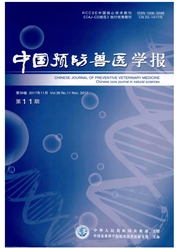

 中文摘要:
中文摘要:
为了解广西反刍动物鹿流行性出血热病毒(EHDV)的感染情况,本研究在广西马山县设立牛羊虫媒病监控点,筛选EHDV抗体阴性的10头牛和5只羊作为哨兵动物,分别混养在EHDV抗体阳性的牛群及羊群中,采取白天放牧,夜间赶回栏舍的方式饲养。采用竞争性ELISA全年监测其抗体转阳情况,取抗体阳转动物的红细胞,接种BHK-21细胞分离EHDV。以RT-PCR、病毒中和试验等对分离株进行鉴定,结果在3头哨兵牛EHDV抗体转阳前后的7份抗凝血中分离到3株病毒,TCID50分别为10^2.5/0.1mL、10^2.83/0.1mL和10^2.5/0.1mL,血清型均为EHDV-5型。该结果为首次在广西牛群中分离到EHDV,表明广西反刍动物存在EHDV感染。本研究为国家监测反刍动物重要虫媒病毒病流行情况和疫病风险分析提供了有价值的参考资料。
 英文摘要:
英文摘要:
To investigate the infection of epizootic hemorrhagic disease virus (EHDV) among ruminants in Guangxi, a site for arbovirus disease surveillance of cattle and sheep was established in Mashan, Nanning. Ten cows and five goats with negative antibody against EHDV were choozed to act as sentinel animals. Then, the seroconversion was monitored by competitive ELISA. The red blood cells of the ruminants whose antibodies against EHDV turned positive were then inoculated into BHK cells to isolate EHDV, and identified through RT-PCR and neutralization test. The results showed that 3 viruses were isolated from 3 of the sentinel cows whose serum turned positive. The titers of the isolates were around 102.5 TCIDsd0.1 mL and their serotypes were EHDV-5. This was the first report that EHDV had been isolated in Guangxi, which proved the existence of EHDV infection among the ruminants in subtropical regions of Guangxi.
 同期刊论文项目
同期刊论文项目
 同项目期刊论文
同项目期刊论文
 期刊信息
期刊信息
